Water / Soil / Ground Environment
Conservation of the Water Environment - Chapter 4
4. Promotion of Water Quality Conservation for Enclosed Water Bodies
1. Status of Enclosed Water Bodies
Environmental Quality Standards (EQS) have been met in a smaller proportion of narrow bays, semi-enclosed seas, lakes, and reservoirs than in other public water areas in Japan. Eutrophication in such enclosed water areas tends to be more severe because of the chronic loading of nutrients, including nitrogen and phosphorus. [Only 74, 53, 67, and 44% of water bodies in Tokyo, Ise, Osaka Bays and lakes and reservoirs, respectively, satisfy the EQS requirements for COD.]
Red tides (Akashio) bloom frequently in such enclosed marine waters. A phenomenon has been observed in Tokyo Bay that is called "blue tide" (Aoshio) and brings anoxic water mass to the surface . Many lakes and reservoirs suffer from intense blooms of cyanobacteria (Aoko). More surveys, studies, and countermeasures should be implemented to conserve water quality in enclosed water bodies and to combat these phenomena.
2. Areawide Total Pollutant Load Control
Efforts must be focused on reducing pollutant loads in populated and industrialized areas around large enclosed water bodies to improve water quality. The Water Pollution Control Law and the related legislation were amended in 1978 to implement a system of Areawide Total Pollutant Load Control System for such large enclosed water bodies.
The Control System is being applied to some large watersheds for which current concentration-based effluent standards, including prefectural stringent effluent standards, were insufficient to meet COD Environmental Quality Standards . Tokyo Bay, Ise Bay, and the Seto Inland Sea have been designated as specified water areas. The areas within these catchment areas are also designated pollution control areas.
Every 5 years, the Prime Minister sets both pollutant load reduction target volume for COD for each specified water area and the target year by which these targets are to be met. After reaching these goals, the relevant prefectural governors determine the pollutant load levels for each prefectural water area and formulate programs to achieve those levels.
The total pollutant load regulation standards, which apply to industries discharging 50 m2 of effluent or more, are at the core of efforts to reduce pollutant loads under this system. The Minister of the Environment promulgates the range of concentration values for load-based standards for 232 industrial sectors within which prefectural governors determine the values for the industry sectors for their prefectures.
The first three stages of total pollutant load control were implemented by the end of fiscal years 1984, 1989, and 1994. The system is now at the fourth stage for establishing the pollutant load reduction target for COD during 1999. The control for industries has been strengthened since 1979. Public sewerage systems have been expanded, and sophisticated treatment for their wastewater has been progressively introduced. Smaller factories and business establishments that are not controlled by the Water Pollution Control Law are requested, through administrative guidance, to make voluntary efforts to reduce their pollutant loads.
Schematic Diagram of Total Pollutant Load Control System 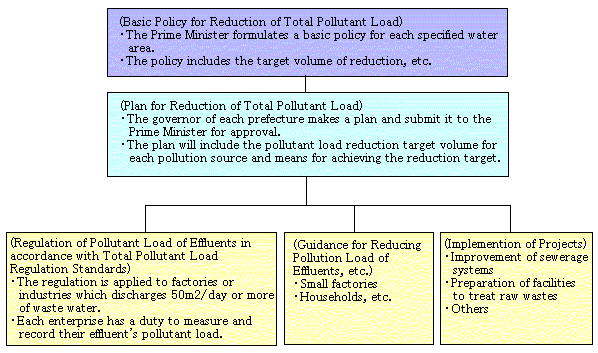
Changes in Pollutant Load and Reduction Targets in Three Areas under Total Pollutant Load Control System
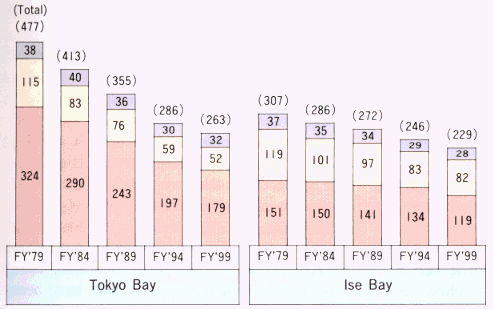
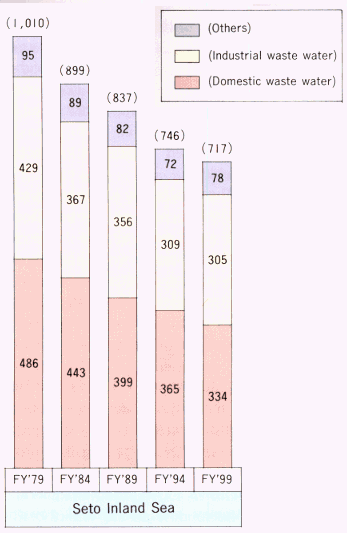
Specified Water Areas and Specified Regions
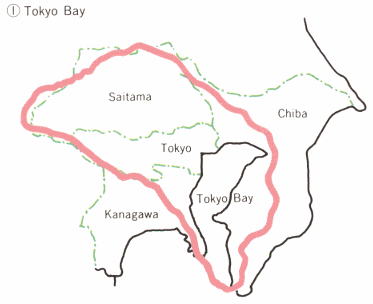
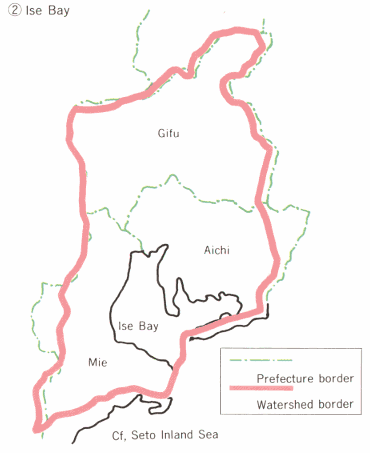
3. Countermeasures against Eutrophication
Eutrophication originally referred to the gradual fertilization of lakes and reservoirs into which nitrogen and phosphorus is supplied by sources from the surrounding area. Recently, increasingly high levels of nutrients have been loaded into bays, lakes, and reservoirs from areas of high population density and industrial activity. The aquatic biota in these areas, such as algal, have propagated explosively and exacerbated water quality problems.
Eutrophication has brought about a variety of harmful effects such as deterioration of the scenic value of lakes and reservoirs because of decreases in transparency or color changes, water supply problems including the obstruction of filters, unpleasant odors and tastes in tap water, and sudden die-offs of valuable fisheries commodities such as fish and shellfish. Marine fisheries have also been seriously damaged by red tides.
(1)Measures for Lakes and Reservoirs
In an attempt to implement countermeasures against eutrophication in lakes and reservoirs, the Environmental Quality Standards (EQS) for nitrogen and phosphorus, major causal factors of eutrophication, were established in 1982. The Director-General of the Environment Agency and prefectural governors have applied the EQS to forty-eight lakes and reservoirs through March 1995.
Uniform national effluent standards for nitrogen and phosphorus discharging into lakes and reservoirs were established in July 1985. Many lakes and reservoirs have been added to the list for nitrogen and phosphorus regulations: a total of 1066 are regulated for phosphorus and 78 out of the 1066 are regulated for both phosphorus and nitrogen.
(2) Measures for Coastal Sea Areas
In 1993, the Environment Agency established the EQS and uniform national effluent standards for nitrogen and phosphorus to reduce marine eutrophication. The effluent standards of nitrogen and phosphorous are effective in the watershed areas of the eighty-eight designated coastal sea waters, including Tokyo Bay, Ise Bay and Osaka Bay where alga growth is very dominant, particularly in summer. EQS for nitrogen and phosphorus have been applied to Tokyo, Ise, Osaka, and other bays and will soon be applied to other important coastal seawaters.
The prefectures of the Seto Inland Sea watershed have taken measures to reduce the total load of phosphorus in the drainage to reduce eutrophication damage in accordance with the Law Concerning Special Measures for Conservation of the Environment of Seto Inland Sea. Moreover, the prefectures surrounding Tokyo Bay and Ise Bay have been promoting administrative programs to attain EQS. Moreover, the prefectures surrounding Tokyo Bay and Ise Bay have been promoting administrative programs to reduce nitrogen and phosphorus before the national establishment of EQS and national effluent standards for nitrogen and phosphorus.
Eutrophication and Organic Pollution
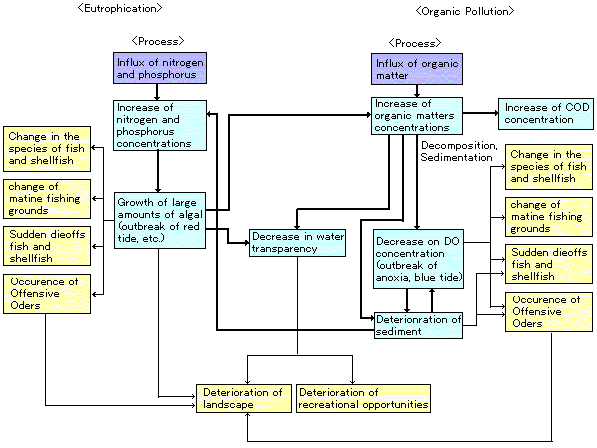
4. Measures for Environmental Conservation in the Seto Inland Sea
The Seto Inland Sea has been blessed with exceptional natural assets and a valuable treasury of fishery resources. However, it is also a semi-enclosed body of water surrounded by high densities of population and industrial activity. In the late 1960s, water pollution from these sources increased rapidly which resulted in demands for vigorous enforcement of environmental conservation measures, particularly with respect to water quality. The Interim Law for Conservation of the Environment of the Seto Inland Sea was enacted in 1973. This law was revised in 1978 to include new policies and became a permanent law under a new name: Law Concerning Special Measures for Conservation of the Environment of the Seto Inland Sea. Comprehensive protective measures have been promoted under this law.
(1) Basic Plan for Conservation of the Environment of the Seto Inland Sea
The basic plan is comprehensive and systematic in enforcing long-term conservation measures to preserve the environment of the Seto Inland Sea. Its major objectives are [1] To maintain water quality at Environmental Quality Standard levels and to reduce the conditions favoring the development of red tides and [2] To preserve the beauty of nature, which includes the seashore and surrounding grass and trees.
(2) Prevention of Damage by Eutrophication
Urgent measures to prevent outbreaks of red tide were instituted in the Law, and a reduction of nutrient loading has already been promoted. Similar to the system of total pollution load control for COD, the Director General of Environment Agency directed prefectural governors to establish administrative guidelines for the reduction of phosphorus loading that included target reduction levels to have been achieved by fiscal 1984, 1989, and 1994. The prefectural governors issued guidelines with directives regarding appropriate methods of disposal for phosphorus-containing wastewater. In 1994, the government added nitrogen to its list of nutrients to be reduced and also began a new direction for the reduction of nutrient loading.
(3) Conservation of the Natural Seashore
The coast of the Seto Inland Sea has been considerably modified, as has other sections of Japan's coasts. Remaining natural seashores are very important. The law authorized prefectures to establish the Natural Seashore Conservation Area System by means of ordinances that mandate pre-notification and recommendation before certain specified activities are undertaken in a Natural Seashore Conservation Area. As of December 1995, ten prefectures had enacted ordinances designating ninety-one Natural Seashore Conservation Areas.
(4) Environmental Consideration in Reclamation
When permitting or approving a reclamation project for the Seto Inland Sea, prefectural governors are required to give full environmental consideration to the project to preserve the peculiarities of this unique water body. In May 1974, the Seto Inland Sea Environmental Conservation Council recommended a basic policy for the enforcement of this provision.
(5) Development of New Measures
The Seto Inland Sea Environmental Conservation Council is discussing "New Measures for Environmental Conservation and Restoration in the Seto Inland Sea" to develop new measures to restore the environment damaged by past development, as an addition to traditional control measures for environmental conservation.
Number of Confirmed Red Tide Outbreaks in the Seto Inland Sea

Seto Inland Sea
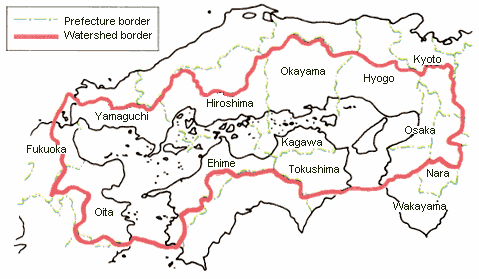
5. Environmental Conservation of Lakes and Reservoirs
Among the many diverse factors responsible for water pollution in lakes and reservoirs are those associated with daily industrial activity in the littoral areas and with the livelihoods of the inhabitants in such areas. The Law Concerning Special Measures for Conservation of Lake Water Quality was enacted in July 1984 because the controls implemented under the existing Water Pollution Control Law were insufficient. The new law, which has been in force since March 1985, includes the following provisions.
- The government establishes and publishes basic policy to conserve water quality in lakes and reservoirs throughout the nation.
- The Prime Minister, by request of prefectural governors, designates lakes and reservoirs in particular need of comprehensive measures to meet the Environmental Quality Standards for lakes and reservoirs (specified lakes and reservoirs) and watersheds relating to water pollution of the designated lakes and reservoirs (specified watersheds).
- Prefectural governors, with the approval of the relevant authorities, establish programs involving combined measures to conserve water quality in lakes and reservoirs, which correspond to both the natural and social conditions in the watershed areas.
- Measures for proper treatment of domestic effluent building on established programs, including sewerage treatment systems as well as purification of lakes and reservoirs by aeration and by dredging bottom sludge, are promoted to improve water quality.
- Specific and detailed water pollution countermeasures are applied as appropriate to the characteristics of each pollution source and to the regulated categories of manufacturing and industrial activity, including proposed expansions of factories and business establishments.
- Appropriate guidance, instructions, and recommendations are given to polluters not subject to legal regulations.
- Preservation of the surroundings of specified lakes and reservoirs is promoted to conserve water quality.
Legal System Concerning Special Measures for Conservation of Lake Water Quality
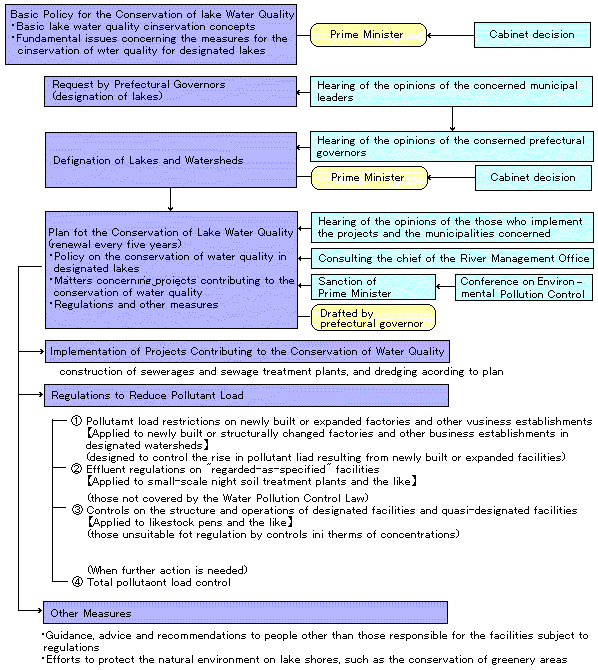
Outline for Specified Lakes
| Lake | Related prefectures | Surface Area | 75th percentile for COD | Total Nitrogen | Total Phosphorus | Water use | |||
|---|---|---|---|---|---|---|---|---|---|
| Present state (FY'96) | Target Values | Present state (FY'94) | Target Values | Present state (FY'94) | Target Values | ||||
| Kamahusa Dam Reservoir |
Miyagi | 2.4 | 2.7 (FY'96) |
-- | -- | 0.017 | 0.013 (FY'96) |
Tap water, Agriculture, Industry Fishery, Angling, Nature conservation | |
| Lake Kasumiga- ura |
Ibaraki Tochigi Chiba |
Nishiura | 10 | 8.1 (FY2000) |
1.1 | 0.98 (FY2000) |
0.14 | 0.10 (FY2000) |
Tap water, Agriculture, Industry, Fishery, Angling, Recreational boating |
| Kitaura | 8.7 | 7.6 (FY2000) |
0.71 | 0.67 (FY20) |
0.086 | 0.086 (FY2000) |
|||
| Hitachi- Tonegawa |
8.8 | 7.4 (FY2000) |
0.75 | 0.84 (FY2000) |
0.090 | 0.078 (FY2000) |
|||
| Lake Inbanuma |
Chiba | 13 | 7.9 (FY2000) |
1.7 | 1.7 (FY2000) |
0.15 | 0.098 (FY2000) |
Tap water, Agriculture, Industry, Fishery, Angling, Recreational boating | |
| Lake Teganuma |
Chiba | 27 | 16 (FY2000) |
4.5 | 4.8 (FY2000) |
0.49 | 0.37 (FY2000) |
Agriculture, Fishery, Angling, Recreational boating | |
| Lake Suwa | Nagano | 1.1 | 5.7 (FY'96) |
1.2 | 1.0 (FY'96) |
0.11 | 0.072 (FY'96) |
Agriculture, Fishery, Angling, Recreational boating | |
| Lake Nojiri |
Nagano | 2.1 | 1.6 (FY'98) |
-- | -- | 0.004 | 0.005 (FY'98) |
Tap, Agriculture. Fishery, Angling, Nature conservation | |
| Lake Biwa | Shiga Kvoto |
Northern Lake | 2.8 | 2.2 (FY2000) |
0.31 | 0.31 (FY2000) |
0.008 | -- | Tap water, Agriculture, Industry, Fishery, Angling, Recreational boating, Bathing, Sightseeing, Nature conservation |
| Southern Lake | 3.6 | 3.3 (FY2000) |
0.39 | 0.39 (FY2000) |
0.018 | 0.015 (FY2000) |
|||
| Lake Nakaumi |
Tottori Shimane |
7.5 | 5.5 (FY'98) |
1.0 | 0.65 (FY'98) |
0.10 | 0.069 (FY'98) |
Fishery, Industry, Sightseeing, Angling | |
| Lake Shinji |
Shimane | 4.7 | 4.1 (FY'98) |
0.56 | 0.44 (FY'98) |
0.053 | 0.040 (FY'98) |
Fishery, Industry, Sightseeing, Angling | |
| Lake Kojima |
Okayama | 10 | 8.8 (FY2000) |
1.8 | 1.7 (FY2000) |
0.21 | 0.17 (FY2000) |
Agriculture, Fishery, Angling | |
- Note:
-
- Source: Environment Agency
- Maximum values are listed for areas having more than one EQS monitoring points 3. Values in Parentheses are the years by which the target must be met
COD Discharge Sources to Three Lakes in FY'95
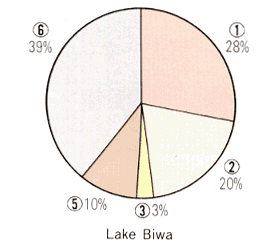 |
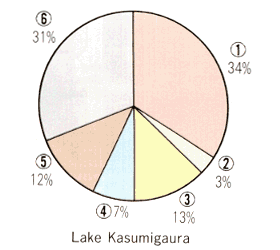 |
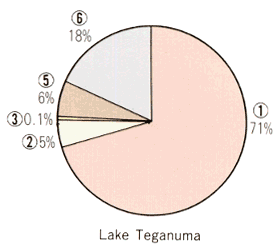 |
|